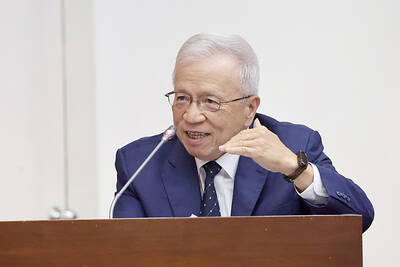Realtors welcomed the Cabinet's proposal to transform some farmland into countryside residential communities, saying the project would benefit farm owners, construction firms and home buyers.
"The project will benefit all three parties that are involved," Benson Liao (廖本勝), president of the Evertrust Rehouse Group (永慶房仲集團), said by telephone yesterday.
Owners of selected farmland would be able to sell their land at market prices, construction firms would have more land on which to construct housing units, while buyers would be able to purchase country homes at lower prices, Liao said.
According to the Cabinet's draft of the act for rebuilding farm villages (農村改建條例), the government plans to transform 10,000 hectares of farmland nationwide into residential communities, each measuring at least 25 hectares, about the size of Da-An Forest Park in Taipei.
Land that is close to cities or with convenient public transport connections would be identified and acquired by local governments and later auctioned off to construction firms.
After deducting the cost of acquiring the land from the selling price, 40 percent of the profit would be paid to the previous owners, 30 percent would go to a fund for rebuilding rural villages, with the remaining 30 percent going to the local government.
Liao said that construction firms, that have been scrambling to acquire a decreasing supply of land in cities, could buy land in the countryside to build vacation homes or communities for the elderly as the nation's population demographic continues to age.
The low building coverage ratio -- the ratio between the area occupied by a building and the overall area of the site -- would guarantee a good quality of life for buyers, he said.
The building coverage ratio for the new developments is 30 percent, meaning, for example, that firms would only be able to build a 30-ping house on a 100-ping plot, while the rest of the space would be used for lawns and community areas.
The ratio for residential areas in cities is 60 percent, for industrial zones 70 percent and for designated commercial areas it is 80 percent.
Another real estate expert appeared more cautious about the draft bill. Su Chi-jung (蘇啟榮), a director at Sinyi Real Estate Inc (信義房屋), the nation's largest housing agency, said for the commercial property market, location would still be the key.
Land close to Taipei City, for example, would attract more bids from construction firms. Plots along the route of the high-speed railway would also be preferential buying targets, Su said.
Construction stocks did not seem to gain much of a boost from the proposed policy yesterday, as the construction sub-index rose by only 2.14 percent.
"The overall outlook for the property market has showed signs of stagnation or even decline, which mitigated the boost the farmland could have given the market," said Alex Huang (黃國偉), vice assistant president at Mega Securities Corp (兆豐證券).
The mainstream product remains luxury apartments priced at NT$1 million (US$30,267) per ping or above, while the demand for vacation homes in the countryside or retirement properties is not strong, Huang said.

JITTERS: Nexperia has a 20 percent market share for chips powering simpler features such as window controls, and changing supply chains could take years European carmakers are looking into ways to scratch components made with parts from China, spooked by deepening geopolitical spats playing out through chipmaker Nexperia BV and Beijing’s export controls on rare earths. To protect operations from trade ructions, several automakers are pushing major suppliers to find permanent alternatives to Chinese semiconductors, people familiar with the matter said. The industry is considering broader changes to its supply chain to adapt to shifting geopolitics, Europe’s main suppliers lobby CLEPA head Matthias Zink said. “We had some indications already — questions like: ‘How can you supply me without this dependency on China?’” Zink, who also

At least US$50 million for the freedom of an Emirati sheikh: That is the king’s ransom paid two weeks ago to militants linked to al-Qaeda who are pushing to topple the Malian government and impose Islamic law. Alongside a crippling fuel blockade, the Group for the Support of Islam and Muslims (JNIM) has made kidnapping wealthy foreigners for a ransom a pillar of its strategy of “economic jihad.” Its goal: Oust the junta, which has struggled to contain Mali’s decade-long insurgency since taking power following back-to-back coups in 2020 and 2021, by scaring away investors and paralyzing the west African country’s economy.

Taiwan Semiconductor Manufacturing Co (TSMC, 台積電) received about NT$147 billion (US$4.71 billion) in subsidies from the US, Japanese, German and Chinese governments over the past two years for its global expansion. Financial data compiled by the world’s largest contract chipmaker showed the company secured NT$4.77 billion in subsidies from the governments in the third quarter, bringing the total for the first three quarters of the year to about NT$71.9 billion. Along with the NT$75.16 billion in financial aid TSMC received last year, the chipmaker obtained NT$147 billion in subsidies in almost two years, the data showed. The subsidies received by its subsidiaries —

BUST FEARS: While a KMT legislator asked if an AI bubble could affect Taiwan, the DGBAS minister said the sector appears on track to continue growing The local property market has cooled down moderately following a series of credit control measures designed to contain speculation, the central bank said yesterday, while remaining tight-lipped about potential rule relaxations. Lawmakers in a meeting of the legislature’s Finance Committee voiced concerns to central bank officials that the credit control measures have adversely affected the government’s tax income and small and medium-sized property developers, with limited positive effects. Housing prices have been climbing since 2016, even when the central bank imposed its first set of control measures in 2020, Chinese Nationalist Party (KMT) Legislator Lo Ting-wei (羅廷瑋) said. “Since the second half of